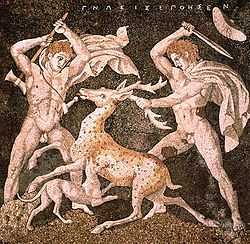Blond

Blond or blonde (see below), or fair hair, is a hair color characterized by low levels of the dark pigment eumelanin. The resultant visible hue depends on various factors, but always has some sort of yellowish color. The color can be from the very pale blond (caused by a patchy, scarce distribution of pigment) to reddish "strawberry" blond colors or golden-brownish ("sandy") blond colors (the latter with more eumelanin). On the Fischer–Saller scale blond color ranges from A to J (blond brown).
Etymology, spelling, and grammar
The word "blond" is first attested in English in 1481[1] and derives from Old French blund, blont meaning "a colour midway between golden and light chestnut".[2] It gradually eclipsed the native term "fair", of same meaning, from Old English fæġer, causing "fair" later to become a general term for "light complexioned". This earlier use of "fair" survives in the proper name Fairfax, from Old English fæġer-feahs meaning "blond hair".
The French (and thus also the English) word "blond" has two possible origins. Some linguists say it comes from Medieval Latin blundus, meaning "yellow", from Old Frankish blund which would relate it to Old English blonden-feax meaning "grey-haired", from blondan/blandan meaning "to mix" (Cf. blend). Also, Old English beblonden meant "dyed" as ancient Germanic warriors were noted for dying their hair. However, linguists who favor a Latin origin for the word say that Medieval Latin blundus was a vulgar pronunciation of Latin flavus, also meaning yellow. Most authorities, especially French, attest the Frankish origin. The word was reintroduced into English in the 17th century from French, and was for some time considered French; in French, "blonde" is a feminine adjective; it describes a woman with blond hair.[3]
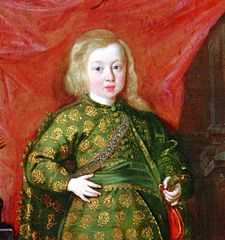
"Blond", with its continued gender-varied usage, is one of few adjectives in written English to retain separate masculine and feminine grammatical genders. Each of the two forms, however, is pronounced identically. American Heritage's Book of English Usage propounds that, insofar as "a blonde" can be used to describe a woman but not a man who is merely said to possess blond(e) hair, the term is an example of a "sexist stereotype [whereby] women are primarily defined by their physical characteristics."[4] The Oxford English Dictionary (OED) records that the phrase "big blond beast" was used in the 20th century to refer specifically to men "of the Nordic type" (that is to say, blond-haired).[5] The OED also records that blond as an adjective is especially used with reference to women, in which case it is likely to be spelt "blonde", citing three Victorian usages of the term. The masculine version is used to describe a plural, in "blonds of the European race",[5] in a citation from 1833 Penny cyclopedia, which distinguishes genuine blondness as a Caucasian feature distinct from albinism.[6]
By the early 1990s, "blonde moment" or being a "dumb blonde" had come into common parlance to mean "an instance of a person, esp. a woman... being foolish or scatter-brained."[7] Another hair color word of French origin, brunet(te) (from the same Germanic root that gave "brown"), also functions in the same way in orthodox English. The OED gives "brunet" as meaning "dark-complexioned" or a "dark-complexioned person", citing a comparative usage of brunet and blond to Thomas Henry Huxley in saying, "The present contrast of blonds and brunets existed among them".[8] "Brunette" can be used, however, like "blonde", to describe a mixed-gender populace. The OED quotes Grant Allen, "The nation which resulted... being sometimes blonde, sometimes brunette."[9]
"Blond" and "blonde" are also occasionally used to refer to objects that have a color reminiscent of fair hair. Examples include pale wood and lager beer. For example, the OED records its use in 19th century poetic diction to describe flowers, "a variety of clay ironstone of the coal measures", "the colour of raw silk",[5] and a breed of ray.[10]
Varieties
Various subcategories of blond hair have been defined to describe someone with blond hair more accurately. Common examples include the following:

- blond/flaxen:[11][12] when distinguished from other varieties, "blond" by itself refers to a light but not whitish blond with no traces of red, gold, or brown; this color is often described as "flaxen".
- yellow: yellow-blond ("yellow" can also be used to refer to hair which has been dyed yellow).
- platinum blond[13] or towheaded:[14][15] whitish-blond; almost all platinum blonds are children. Although it is found on people in Northern Europe. "Platinum blond" is often used to describe bleached hair, while "towheaded" generally refers to natural hair color.
- sandy blond:[16][17] grayish-hazel or cream-colored blond.
- golden blond: a darker to rich, golden-yellow blond.
- strawberry blond,[18] Venetian blond[19] or honey blond: reddish blond.
- dirty blond[20] or dishwater blond:[21] dark blond with flecks of golden blond and brown.
- ash-blond:[22] ashen or grayish blond.
- bleached blond, bottle blond, or peroxide blond[23] terms used to refer to artificially colored blond hair.
Evolution of blond hair

Natural lighter hair colors occur most often in Europe and less frequently in other areas.[24] In Northern European populations, the occurrence of blond hair is very frequent. The hair color gene MC1R has at least seven variants in Europe giving the continent a wide range of hair and eye shades. Based on recent genetic research carried out at three Japanese universities, the date of the genetic mutation that resulted in blond hair in Europe has been isolated to about 11,000 years ago during the last ice age.[25]
A typical explanation found in the scientific literature for the evolution of light hair is related to the requirement for vitamin D synthesis and northern Europe's seasonal deficiency of sunlight.[26] Lighter skin is due to a low concentration in pigmentation, thus allowing more sunlight to trigger the production of vitamin D. In this way, high frequencies of light hair in northern latitudes are a result of the light skin adaptation to lower levels of sunlight, which reduces the prevalence of rickets caused by vitamin D deficiency. The darker pigmentation at higher latitudes in certain ethnic groups such as the Inuit is explained by a greater proportion of seafood in their diet. As seafood is high in vitamin D, vitamin D deficiency would not create a selective pressure for lighter pigmentation in that population.
An alternative hypothesis was presented by Canadian anthropologist Peter Frost, who claims blond hair evolved very quickly in a specific area at the end of the last ice age by means of sexual selection.[27] According to Frost, the appearance of blond hair and blue eyes in some northern European women made them stand out from their rivals at a time of fierce competition for scarce males.[28]
A theory propounded in The History and Geography of Human Genes (1994), says blond hair became predominant in Northern Europe beginning about 3,000 BC, in the area now known as Lithuania, among the recently arrived linguistically Proto-Indo-European settlers (according to the Kurgan hypothesis), and the trait spread quickly through sexual selection into Scandinavia. As above, the theory assumes that men found women with blond hair more attractive.[29]
It is now hypothesized by researchers that blond hair evolved more than once. Published in May 2012 in Science, a study of people from the Solomon Islands in Melanesia found that an amino acid change in TYRP1 produced blonde hair.[30][31]
Relation to age
Blond hair is most common in light-skinned infants and children,[32] so much so that the term "baby blond" is often used for very light colored hair. Babies may be born with blond hair even among groups where adults rarely have blond hair although such natural hair usually falls out quickly. Blond hair tends to turn darker with age, and many children's blond hair turns light, medium, dark brown or black before or during their adult years.[32]
As blond hair tends to turn brunette with age, natural blonde hair is rare and makes up approximately 2% of the world's population.[33]
Geographic distribution
Europe

Blond hair is most common in Scandinavia and Baltic Sea countries, where true blondism is believed to have originated. The pigmentation of both hair and eyes is lightest around the Baltic Sea, and darkness increases regularly and almost concentrically around this region[34] with countries such as England, Scotland, Sweden, Norway, Denmark, the Netherlands, Germany, Finland, Estonia, Latvia, Lithuania, Poland, Belarus, Ukraine, Russia, etc. generally having larger proportions of blond people than countries further south in Europe.
In France, according to a source published 1939, blondism is more common in Normandy, and less common in the Pyrenees and the Mediterranean seacoast; 26% of French population has blond or light brown hair.[35] A 2007 study of French females showed that by then roughly 20% were blonde, however half of these blondes were fully fake. Roughly ten percent of french females are natural blondes, of which 60% bleach their hair to a lighter nuance of blonde.[36]
In Portugal, 11% of the population shows traces of blondism, peaking at 14.3–15.1% in Povoa de Varzim in Northern Portugal.[37][38] In northern Spain, 17% of the population is blond, but in southern Spain just 2% is blond.[39] In Italy, according to 20th century geneticist Biasutti, 12% of Italians exhibit various shades of blond,[40] but regional contrasts are pronounced with a greater occurrence in the northern and central regions (Veneto, Friuli, Valle d'Aosta and Bolzano) where the figure can reach 15%-20% and a lesser occurrence in the south such as Sardinia where only 1.7% exhibited blondism and, with the exception of Benevento and surrounding area where blondism reaches 10-14.9%, compared to other southern regions where it averages around 2-7%.
Africa
Blondism is also a common sight among Berbers of North Africa, especially in the Rif and Kabyle region. Blondism frequency varies among Berbers from 1% among Jerban Berbers, 4% among Mozabite Berbers and Shawia Berbers, to 11% among Kabyle Berbers.[41] In South Africa there is a significant population of Whites, mainly from Dutch and English ancestry, blondes may account for 3-4% of the South African population.
A number of blonde naturally mummified bodies of common people (i.e. not proper mummies) dating to Roman times have been found in the Fag el-Gamous cemetery in Egypt, "Of those whose hair was preserved 54% were blondes or redheads, and the percentage grows to 87% when light-brown hair color is added".[42] Excavations have been ongoing since the 1980's. Burials seem to be clustered by hair-colour.[43]
Oceania

Aboriginal Australians, especially in the west-central parts of the continent, have a high frequency of natural blond-to-brown hair,[44] with as many as 90–100% of children having blond hair in some areas.[45] The trait among Indigenous Australians is primarily associated with children. In maturity the hair usually turns a darker brown color, but sometimes remains blond.[45] Blondness is also found in some other parts of the South Pacific, such as the Solomon Islands,[30][31] Vanuatu, and Fiji, again with higher incidences in children. Blond hair in Melanesians is caused by an amino acid change in the gene TYRP1.[30] This mutation is at a frequency of 26% in the Solomon Islands and is absent outside of Oceania.[30]
Americas
The United States, Canada, Argentina and Uruguay (along with Australia and New Zealand) are overall considered as the only countries with a great majority of White population outside Eurasia because a great majority of their population has European origins.[46] Because of it, these countries have the highest frequency of naturally blonds. There are also other American countries with a lower but noticeable frequency, such as Brazil, Chile, Cuba and Costa Rica. Blonds are also found (but rarely) in the rest of the American countries, where they account for 1% or less of the population.
Asia

Blonde hair can be found in any region of Asia, including West Asia, East Asia, Central Asia, and South Asia. In these parts of Asia blond hair is generally seen among children that usually turns into a shade of dark brown in adulthood. Environmental factors, for example, sun exposure and nutrition status often contributes to change in hair color in Asia.[47]
DNA analysis of ancient buryal mounds in Kazakhstan (3300 years to 1500 years old) identified that the original population of central Asia was European, that later mixed with east asian peoples.[48] In 2006 a well preserved mummy of a blond Scythian warrior from ca 700 BC was found in the permafrost at 2,600 meters in the Altai mountains of Mongolia (bordering to Kazakhstan.[49] A 2009 study found that light hair colors were already present as far as southern Siberia during the Bronze Age.[50] Blond children are found at comparatively high frequency among the Nuristani people.[51] Tajik children can also have blond hair, more prevalent in the Pamir region.[52] An estimate of 75% of Russia is geographically considered North Asia, however, the Asian portion of Russia contributes to only an estimate of 20% of Russia's total population.[53] North Asia's population has an estimate of 1-19% with light hair.[54][55]

The country India had numerous invasions and foreign rulers that can date back to prehistoric Neolithic Era during the early civilizations that have introduced genetic variations to the country.[56] Theories of prehistoric Indo-European migrations from the west include the Indo-Aryan migration theory and the migration of the Indo-Iranians. In classical times following the 4th century BC invasion by Alexander the Great there were for several hundred years Greek setlements associated with the Greco-Bactrian Kingdom and the Indo-Greek Kingdom at the edges of India.
Among the most noted invasions occurred during India's association with the Roman Empire in 50 AD and during the British Empire from the 1600s to 1947.[57][58] The British rule in India involved many European nations, specifically the United Kingdom, Portugal, France, and the Netherlands. These nations set up trade and settled along the East and West water ports of India and many have since integrated with local communities.[59][60] From the 1960s through 1970s Hippie trails from Europe to India allowed the settlers to reside along the coastlines of India that further brought genetic variations, including blond hair.[61][62]
From the times of the Russian Tsardom of the 17th century through the Soviet Union rule in the 20th century many ethnic Russians, Ukrainians, Belarusians, Lithuanians, Latvians, Estonians, Poles, Germans were settled in or exiled en masse to Siberia and Central Asia. Blond hair is often seen in these groups, whereas the indigenous peoples are more likely to be dark haired.[63][64][65] For instance, their descendants currently contribute to an estimated 25% of Kazakhstan's total population.[66]

The Tarim mummies are a series of mummies discovered in the Tarim Basin in present-day Xinjiang, China, which date from 1800 BCE to the first centuries BCE.[67][68] The mummies, particularly the early ones, are frequently associated with the presence of the Indo-European Tocharian languages in the Tarim Basin,[69] Many of the mummies have been found in very good condition, owing to the dryness of the desert and the desiccation it produced in the corpses. The mummies share many typical Europoid body features (elongated bodies, angular faces, recessed eyes), and many of them have their hair physically intact, ranging in color from blond to red to deep brown, and generally long, curly and braided. The Turkic Uyghur tribes expanded into the Tarim Basin in the 9th century AD and absorbed the original population.
It is possible that the Brahmin caste in India historically contained natural blondes. According to Gendün Chöphel, In the Buddhacarita it is written that "Brahmins of uncorrupted caste have blond hair and light blue eyes" while In the Pramanavarttikatika "it states that a sign of the degeneration of the brahmin caste is the fact that brahmin characteristics like blond hair are no longer seen."[70]
The Indian god Indra has various descriptions of appearance, amongst other in the Rigveda as "... the Iron One with yellow beard and yellow hair"[71]
Folklore and mythology
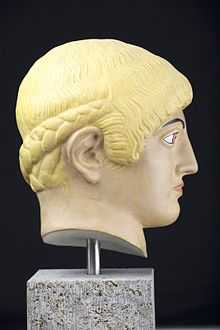
Southern Europe
The Greek gods are cited as varying in their appearances. While Poseidon was described as having a blue-black beard, and Zeus blue-black eyebrows, Pindar described Athena as fair-haired, and Pheidas described her as golden-haired. Hera, Apollo and Aphrodite were also described as blonds.[72] Pindar collectively described the Homeric Danaans of the time of the war between Argos and Thebes as fair-haired.[72] The Spartans are described as fair-haired by Bacchylides. In the work of Homer, Menelaus the king of the Spartans is, together with other Achaean leaders, portrayed as blond.[72] Although dark hair colours were predominant in the works of Homer, there is only one case of a dark hero, and that is when the blond Odysseus is transformed by Athena and his beard becomes blue-black. Other blond characters in Homer are Peleus, Achilles, Meleager, Agamede, and Rhadamanthys.[72] According to Francis Owens,[73] Roman literary records describe a large number of well-known Roman historical personalities as blond. In addition, 250 individuals are recorded to have had the name Flavius, meaning blond, and there are various people named Rufus and Rutilius, meaning red haired and reddish-haired, respectively. The following Roman gods are said to have had blond hair: Amor, Apollo, Aurora, Bacchus, Ceres, Diana, Jupiter, Mars, Mercury, Minerva and Venus.[73] An emperor, Nero, descended from an aristocratic family, is by the historian Suetonius described as: "... his hair light blond,... his eyes blue..."[74] Augustus, founder of the Roman Empire, is by Suetonius described as having hair that was ... slightly curly and inclining to golden.[75]
The traces of hair color on Greek korai likelly reflect the colors the artists saw in real-life hair. The hair have a wide range of shades of blonde red and brown. The minority of statues with blond hair range from strawberry blond up to platinum blond.[76] Sappho of Lesbos (630-570 BC) wrote that purple colored wraps as headdress were good enough, except if the hair was blonde; ...for the girl who has hair that is yellower than a torch (it is better to decorate it) with wreaths of flowers in bloom.[77]
According to Victoria Sherrow - author of 14 picture books for children - those Romans who were fair-haired preferred to dye their hair dark in the early period of Ancient Rome; at one point in time blond hair was even associated with prostitutes.[78] The preference changed to bleaching the hair blond when Greek culture, which practiced bleaching, reached Rome, and was reinforced when the legions that conquered Gaul returned with blond slaves.[78] Sherrow also states that Roman women tried to lighten their hair, but the substances often caused hair loss, so they resorted to wigs made from the captives’ hair.[79]
Juvenal wrote in a satirical poem that Messalina, Roman empress of noble birth, would hide her black hair with a blond wig for her nightly visits to the brothel: sed nigrum flavo crinem abscondente galero intravit calidum veteri centone lupanar.[80] In his Commentary on the Aeneid of Virgil, Maurus Servius Honoratus noted that the respectable matron was only black haired, never blond.[81] In the same passage, he mentioned that Cato the Elder wrote that some matrons would sprinkle golden dust on their hair to make it reddish-color. Emperor Lucius Verus (130 – 169 AD) was said to sprinkle gold-dust on his blond hair to make it even blonder and brighter.[82]
From an ethnic point of view, Roman authors associated blond and reddish hair with the Gauls and the Germans: e.g., Virgil describes the hair of the Gauls as "golden" (aurea caesaries),[83] Tacitus wrote that "the Germans have fierce blue eyes, red-blond hair (rutilae comae), huge (tall) frames";[84] in accordance with Ammianus, almost all the Gauls were "of tall stature, fair and ruddy".[85]
| Ancient depictions | ||||||||||||
|---|---|---|---|---|---|---|---|---|---|---|---|---|
| ||||||||||||
| Statues form part of Gods in Color |
Northern Europe

In Norse mythology, the goddess Sif has famously blonde hair, which some scholars have identified as representing golden wheat.[86] In the Poetic Edda poem Rígsþula, the blond man Jarl is considered to be the ancestor of the dominant warrior class.
In Northern European folklore, supernatural beings value blonde hair in humans. Blonde babies are more likely to be stolen and replaced with changelings, and young blonde women are more likely to be lured away to the land of the beings.[87] Elves and fairies were often portrayed with blond hair in illustrations in children's book of fairy tales. This continues the theme that blond hair is associated with beauty and goodness.
Contemporary popular culture
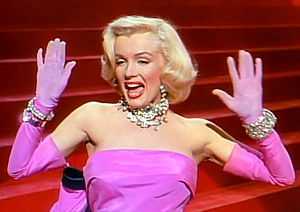
In contemporary popular culture, it is often stereotyped that men find blond women more attractive than women with other hair colors.[78] For example, Anita Loos popularized this idea in her 1925 novel Gentlemen Prefer Blondes.[78] Blondes are often assumed to have more fun; for example, in a Clairol commercial for hair colorant, they use the phrase "Is it true blondes have more fun?"[78] Some women have reported they feel other people expect them to be more fun-loving after having lightened their hair.[78] In North America, the "blonde stereotype" is also associated with being less serious or less intelligent.[78] This can be seen in blonde jokes.[78] It is believed the originator of the "dumb blonde" was an 18th-century blonde French prostitute named Rosalie Duthé whose reputation of being beautiful but dumb inspired a play about her called Les Curiosites de la Foire (Paris 1775).[78] Blonde actresses have contributed to this perception; some of them include Marilyn Monroe, Judy Holliday, Jayne Mansfield, and Goldie Hawn during her time at Laugh-In.[78]
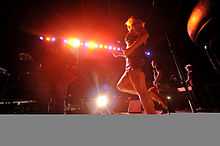
Alfred Hitchcock preferred to cast blonde women for major roles in his films as he believed that the audience would suspect them the least, comparing them to "virgin snow that shows up the bloody footprints", hence the term "Hitchcock blonde".[88] This stereotype has become so ingrained it has spawned counter-narratives, such as in the 2001 film Legally Blonde in which Reese Witherspoon succeeds at Harvard despite biases against her beauty and blonde hair,[78] and terms developed such as cookie cutter blond (CCB), implying standardized blond looks and standard perceived social and intelligence characteristics of a blond. Many actors and actresses in Latin America and Hispanic United States have blond hair, blue eyes, and pale skin.[89][90][91][92][93][94][95][96][97]
In colloquial Quebec French, "ma blonde" means "my girlfriend", regardless of the color of the specific woman's hair. Such is for example the reference in the name of the still-current 17th century chanson "Auprès de ma blonde".
See also
- Science
- Human hair color
- Brown hair (also Chestnut hair)
- Black hair
- Red hair (also Auburn hair)
- Disappearing blonde gene
- Society
- Blonde vs. brunette rivalry
- Blonde stereotype
- Ganguro
- Go Blonde Festival
References
- ↑ "blonde|blond, adj. and n.". OED Online. March 2012. Oxford University Press. Web. 17 May 2012.
- ↑ Harper, Douglas. "Blond (Adj.)." Online Etymology Dictionary. Web. 17 May 2012.
- ↑ Origin of "blonde", from Online Etymology Dictionary.
- ↑ "5. Gender: Sexist Language and Assumptions § 2. blond / brunet". The American Heritage Book of English Usage. A Practical and Authoritative Guide to Contemporary English. Bartleby.com. 1996. Archived from the original on September 7, 2008. Retrieved October 24, 2013.
- ↑ 5.0 5.1 5.2 "blonde, blond, a. and n." The Oxford English Dictionary. 2nd ed. 1989. OED Online. Oxford University Press. 5 Aug. 2010.
- ↑ Penny cyclopaedia of the Society for the Diffusion of Useful Knowledge, s.v. Albinos. Society for the Diffusion of Useful Knowledge (Great Britain, 1833).
- ↑ "blonde, blond, a. and n." The Oxford English Dictionary. June 2006 [draft editions]. OED Online. Oxford University Press. 5 Aug. 2010
- ↑ "brunet, a. and n." The Oxford English Dictionary. June 2006 [draft editions]. OED Online. Oxford University Press. 5 Aug. 2010
- ↑ "brunette, n. and a." The Oxford English Dictionary. June 2006 [draft editions]. OED Online. Oxford University Press. 5 Aug. 2010.
- ↑ "blonde, blond, a. and n." The Oxford English Dictionary. Additions Series 1997. OED Online. Oxford University Press. 5 Aug. 2010.
- ↑ "flaxen". The American Heritage Dictionary of the English Language: Fourth Edition. Yahoo! Education. 2000. Archived from the original on May 12, 2007. Retrieved October 24, 2013.
- ↑ "Flaxen" in Merriam-Webster
- ↑ "Platinum blonde" in Merriam-Webster
- ↑ "towhead". The American Heritage Dictionary of the English Language: Fourth Edition. Yahoo! Education. 2000. Archived from the original on June 26, 2008. Retrieved October 24, 2013.
- ↑ "Towhead" in Merriam-Webster
- ↑ "sandy". The American Heritage Dictionary of the English Language: Fourth Edition. Yahoo! Education. 2000. Archived from the original on April 10, 2005. Retrieved October 24, 2013.
- ↑ "Sandy" in Merriam-Webster
- ↑ "strawberry blond". The American Heritage Dictionary of the English Language: Fourth Edition. Yahoo! Education. 2000. Archived from the original on February 12, 2009. Retrieved October 24, 2013.
- ↑
- Nenarokoff-Van Burek, Anne (2013). Ariadne's Thread: The Women in My Family. FriesenPress. ISBN 9781460207192. Retrieved October 24, 2013.
- Davydov, Denis Vasilʹevič (1999). Troubetzkoy, Gregory, ed. In the Service of the Tsar Against Napoleon: The Memoirs of Denis Davidov, 1806-1814. Greenhill Books/Lionel Leventhal, Limited. ISBN 9781853673733. Retrieved October 24, 2013.
- Sutherland, Daniel E. (March 1, 2000). The Expansion of Everyday Life, 1860-1876. University of Arkansas Press. ISBN 9781610751452. Retrieved October 24, 2013.
- Browne, Ray Broadus; Kreiser, Lawrence A. (January 1, 2003). The Civil War and Reconstruction. Greenwood Publishing Group. ISBN 9780313313257. Retrieved October 24, 2013.
- France, Anatole (2010). Works of Anatole France. MobileReference. ISBN 9781607785422. Retrieved October 24, 2013.
- ↑ "Dirty blond" at Dictionary.com
- ↑ "Dishwater blonde" in Encarta. Archived from the original on 2009-10-31.
- ↑ "Ash-blond" in Merriam-Webster
- ↑ "Peroxide blond" at Dictionary.com
- ↑ "Cavegirls were first blondes to have fun", from The Times. Note, the end of the Times article reiterates the disappearing blonde gene hoax; the online version replaced it with a rebuttal.
- ↑ Dobson, Roger; Taher, Abul (2006-02-26). "CorrectedCavegirls were first blondes to have fun". The Times (London). Retrieved 2010-04-26.
- ↑ Robins, Ashley H. Biological perspectives on human pigmentation. Cambridge University Press, 1991, pp. 195–208.
- ↑ Abstract: "European hair and eye colour: A case of frequency-dependent sexual selection?" from Evolution and Human Behavior, Volume 27, Issue 2, Pages 85-103 (March 2006)
- ↑ Clout, Laura (2007-11-19). "Blonde women make men less clever". The Daily Telegraph (London). Retrieved 2010-04-26.
- ↑ Cavalli-Sforza, Luigi Luca; Menozzi, Paolo; Piazza, Alberto (1994). "Europe". The History and Geography of Human Genes. Princeton, New Jersey: Princeton University Press. p. 266. ISBN 978-0-691-08750-4.
- ↑ 30.0 30.1 30.2 30.3 Kenny, Eimear E.; Timpson, Nicholas J. (4 May 2012). "Melanesian Blond Hair Is Caused by an Amino Acid Change in TYRP1". Science (journal).
- ↑ 31.0 31.1 Corbyn, Zoë (3 May 2012). "Blonde hair evolved more than once". Nature.com.
- ↑ 32.0 32.1 Ridley, Matt. Red Queen: Sex and the Evolution of Human Nature. Published by HarperCollins, 2nd ed. 2003, pp. 293–294.
- ↑ http://webspace.ship.edu/cgboer/race.html"
- ↑ Cavalli-Sforza, L., Menozzi, P. and Piazza, A. (1994). The History and Geography of Human Genes. Princeton: Princeton University Press.
- ↑ Coon, Carleton S. The Races of Europe. Retrieved 9 July 2013.
France as a whole, finds but 4 per cent of black and near-black hair color, 23 per cent of dark brown, 43 per cent of medium brown,. 14 per cent of light brown, 12 per cent of various degrees of blond, and some 4 per cent of reddish-brown and red. (...)
The regional distribution of hair color in France follows closely that of stature. Although the position of the French in regard to hair pigmentation is intermediate between blond and black, the diagonal line from Mont St. Michel to Orleans, Lyons, and the Italian border divides the country into a northeastern quadrant, in which the hair is somewhat lighter than medium, and a southwestern, in which it is somewhat darker. High ratios of black and very dark brown hair are found not in the typically Alpine country, but along the slope of the Pyrenees, in Catalan-speaking country, and on the Mediterranean seacoast. Blond hair is commonest along the Channel, in regions settled by Saxons and Normans, in Burgundy and the country bordering Switzerland, and down the course of the Rhône. In northern France it seems to follow upstream the rivers which empty into the Channel. The hair color of the departments occupied by Flemish speakers, and of others directly across the Channel from England in Normandy, seems to be nearly as light as that in the southern English counties; the coastal cantons of Brittany are lighter than the inland ones, and approximate a Cornish condition. In the same way, the northeastern French departments are probably as light-haired as some of the provinces of southern Germany. - ↑ La Depeche, 5 millions de blondes en France, dont 50% de fausses
- ↑ Tamagnini Eusebio: "A Pigmentacao dos Portugueses". Coimbra: Universidade de Coimbra. Instituto de Antropologia Portuguesa, 1936. Contribuicoes para o Estudo da Antropologia Portuguesa. Vol. VI, no. 2, 1936 pp. 121–197.
- ↑ Mendes Correa: American Journal of Physical Anthropology, Vol 2, 1919.
- ↑ Coon, Carleton S. The Races of Europe. Retrieved 9 July 2013.
In Spain, as a whole, some 29 per cent of the male population has black hair, some 68 per cent dark brown, while traces of blondism are visible in 17 per cent. (...) As in southern Spain, the skin color is evenly divided between a light brown, 45 per cent, and brunet-white, 45 per cent, while pinkish-white skins are found in only one-tenth of the population.122 Again as in Spain, the prevailing hair color is dark brown, which amounts to 68 per cent of the total; blond and red hair is limited to 2 per cent
- ↑ http://www.theapricity.com/snpa/bilder/biasuttiblondism.jpg
- ↑ "(Chapter XI, section 13) Eastern Barbary, Algeria and Tunisia". SNPA. Retrieved 13 March 2013.
- ↑ C. Wilfred Griggs, "Excavating a Christian Cemetery Near Selia, in the Fayum Region of Egypt", in Excavations at Seila, Egypt, ed. C. Wilfred Griggs, (Provo, Utah: Religious Studies Center, Brigham Young University, 1988), 74–84.
- ↑ Egyptian Cemetery May Contain a Million Mummies History, December 19, 2014
- ↑ "Modern Human Variation: Overview". Anthro.palomar.edu. 2009-11-08. Retrieved 2009-12-20.
- ↑ 45.0 45.1 "Gene Expression: Blonde Australian Aboriginals". Gnxp.com. Retrieved 2009-12-20.
- ↑ European Migration and Imperialism
- ↑ Gray, John. (1977). The World of Hair, A Scientific Companion, Macmillan Press Limited
- ↑ When East Met West in Kazakhstan Science, 2004-05-04
- ↑ Archeological Sensation: Ancient Mummy Found in Mongolia Spiegel August 25, 2006
- ↑ Christine Keyser, Caroline Bouakaze, Eric Crubézy, Valery G. Nikolaev, Daniel Montagnon, Tatiana Reis and Bertrand Ludes (2009). Ancient DNA provides new insights into the history of south Siberian Kurgan people. Human Genetics. Volume 126, Number 3, 395-410, doi:10.1007/s00439-009-0683-0.
- ↑ Dupree, L. "Afghānistān: (iv.) ethnography". In Ehsan Yarshater. Encyclopædia Iranica (Online ed.). United States: Columbia University. Retrieved 5 November 2011.
- ↑ Shoumatoff, Nicholas; Shoumatoff, Nina (2000). Around the Roof of the World. University of Michigan Press. p. 9. ISBN 0-472-08669-3.
- ↑ Vishnevsky, Anatoly. (15 August 2000). "Replacement Migration: Is it a solution for Russia?" (PDF). EXPERT GROUP MEETING ON POLICY RESPONSES TO POPULATION AGEING AND POPULATION DECLINE /UN/POP/PRA/2000/14. United Nations Population Division, Department of Economic and Social Affairs. pp. 6,10.
- ↑ Gene pool and genegeography of population: Vol. 1. Nauka. 2000. ISBN 5020258237.
- ↑ Balaresque, Patricia; Bowden, Georgina R.; Adams, Susan M.; Leung, Ho-Yee; King, Turi E. et al. (2010). Penny, David, ed. "A Predominantly Neolithic Origin for European Paternal Lineages". PLOS Biology (Public Library of Science) 8 (1): e1000285. doi:10.1371/journal.pbio.1000285. PMC 2799514. PMID 20087410. Retrieved August 19, 2014.
- ↑ Basham, A. (1985). Prehistoric india to 1000 bc. (2nd & 3rd ed.). Sidgwick&Jackson.
- ↑ Asimov, Isaac (1967). The Roman Empire. Houghton Mifflin. ISBN 0395065771.
- ↑ Bayly, Christopher Alan (1994). The Raj: India and the British, 1600-1947. Abbeville Press. ISBN 1558598480.
- ↑ Cumming, M. (2013). Human heredity: Principles and issues. ISBN 1133106870.
- ↑ Stuart, P. Prehistoric India to 1000 b. c ([1950]). Harmondsworth, Middlesex: Penguin Books.
- ↑ Andrea, A. (2007). Global nomads: Techno and new age as transnational countercultures in ibiza and goa. Routledge.
- ↑ Hall, Michael (2007) Remembering the Hippie Trail: travelling across Asia 1976-1978, Island Publications
- ↑ "The results of the national population census in 2009". Agency of Statistics of the Republic of Kazakhstan. 12 November 2010. Retrieved 21 January 2010.
- ↑ Flynn, Moya (1994). Migrant resettlement in the Russian federation: reconstructing homes and homelands. ISBN 1843311178.
- ↑ Ramet, S. Petra (1993). Religious Policy in the Soviet Union. Cambridge University Press. ISBN 9780521416436.
- ↑ Robert Greenall, Russians left behind in Central Asia, BBC News, 23 November 2005
- ↑ Mallory & Mair (2000), p. 237.
- ↑ Wade, Nicholas (2010-03-15). "A Host of Mummies, a Forest of Secrets". The New York Times. Retrieved 2011-06-09.
- ↑ Baumer (2000), p. 28.
- ↑ Gendun Chopel, Grains of Gold: Tales of a Cosmopolitan Traveler. University of Chigago Press. p.131. ()
- ↑ Rigveda: Rig Veda, Book 10, Hymn XCVI, P. 8
- ↑ 72.0 72.1 72.2 72.3 Myres, John Linton (1967). Who were the Greeks?, pp. 192-199. University of California Press.
- ↑ 73.0 73.1 " (Francis Owen,The Germanic people; their Origin Expansion & Culture", 1993 Barnes & Noble Books ISBN 0-88029-579-1, page 49.)
- ↑ "Suetonius • Life of Nero". Penelope.uchicago.edu. Retrieved 2008-12-22.
- ↑ "Suetonius • The Life of Augustus". Penelope.uchicago.edu. Retrieved 2015-04-10.
- ↑ Mary Stieber, The Poetics of Appearance in the Attic Korai, p. 66-68. University of Texas Press
- ↑ Mary Stieber, The Poetics of Appearance in the Attic Korai, p.156. University of Texas Press
- ↑ 78.0 78.1 78.2 78.3 78.4 78.5 78.6 78.7 78.8 78.9 78.10 Victoria Sherrow. Encyclopedia of hair: a cultural history. Page 149
- ↑ Victoria Sherrow, For Appearance' Sake: The Historical Encyclopedia of Good Looks, Beauty, and Grooming, Greenwood Publishing Group, p. 136, Google Books
- ↑ Juv. 2.6.120-121
- ↑ Serv. A. 4.698
- ↑ Michael Grant. The Antonines
- ↑ Virg. Aen. 8.659
- ↑ Tac. Germania 4
- ↑ Amm. 15.12.1
- ↑ Ellis Davidson, H. R. (1965). Gods and Myths of Northern Europe, page 84. Penguin. ISBN 0-14-013627-4
- ↑ Katharine Briggs, An Encyclopedia of Fairies, Hobgoblins, Brownies, Boogies, and Other Supernatural Creatures, "Golden Hair", p194. ISBN 0-394-73467-X
- ↑ Allen, Richard (2007). Hitchcock's Romantic Irony. Columbia University Press. ISBN 978-0-231-13574-0.
- ↑ Quinonez, Ernesto (2003-06-19). "Y Tu Black Mama Tambien". Retrieved 2008-05-02.
- ↑ The Blond, Blue-Eyed Face of Spanish TV
- ↑ Blonde, Blue-Eyed Euro-Cute Latinos on Spanish TV
- ↑ Latinos Not Reflected on Spanish TV
- ↑ What are Telenovelas? – Hispanic Culture
- ↑ Racial Bias Charged On Spanish-Language TV
- ↑ Black Electorate
- ↑ Jones, Vanessa E. (2004-08-19). "Pride or Prejudice?". Boston.com. Retrieved 2010-09-08.
- ↑ POV - Corpus Film Description
External links
| Look up blond in Wiktionary, the free dictionary. |
| Wikimedia Commons has media related to Blond hair. |
| ||||||||||||||

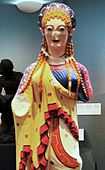
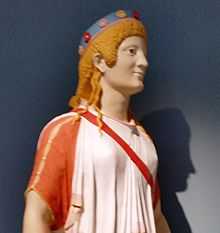
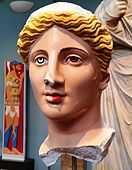
.jpg)
